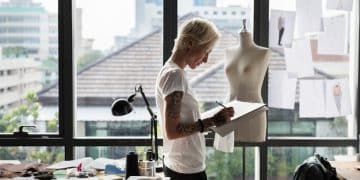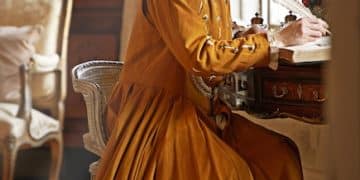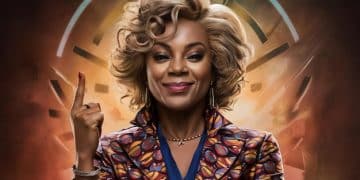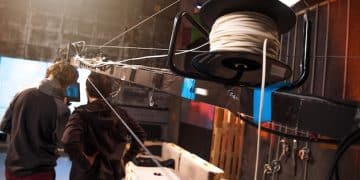The Unsung Heroes of Film: A Tribute to Costume Designers
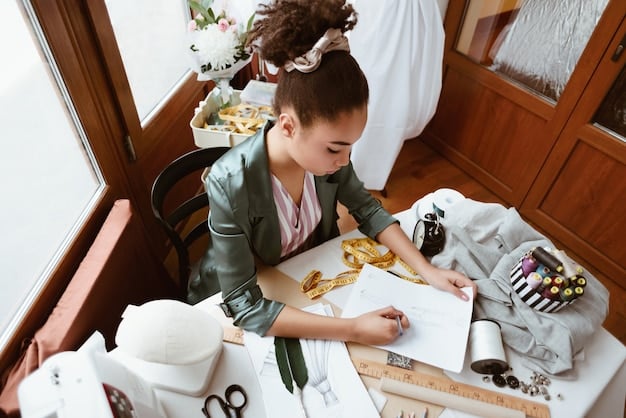
Anúncios
Costume designers are the unsung heroes of film, crafting visual narratives that define characters and transport audiences to different worlds.
Anúncios
Movies captivate us with their stories, visuals, and performances, but often, the magic behind the screen goes unnoticed. While actors and directors receive accolades, the artistry of costume designers, the true unsung heroes of film, remains largely uncelebrated. These creative visionaries weave narratives through fabric, color, and design, bringing characters to life and shaping the very essence of the stories we love.
The Role of Costume Designers in Film
Costume designers are not merely stylists; they are storytellers. Their work goes far beyond selecting pretty clothes. They delve into scripts, research historical periods, and collaborate with directors and actors to create wardrobes that reflect a character’s personality, background, and journey.
Anúncios
Understanding Character Through Clothing
Costumes speak volumes about a character before they even utter a word. A character’s clothing relays a substantial amount of information to the audience, and it is no accident.
Enhancing the Narrative
Costume designers contribute to the overall narrative of a film, creating visual cues that guide the audience through the story. Changing wardrobes, colors, and textures can signal shifts in character development, plot twists, and thematic undertones.

Costume designers weave together many items to create the film’s whole aesthetic.
- They provide historical context.
- They illuminate character arcs.
- They add visual richness.
In essence, they are integral to the success of any film.
Costume designers are essential collaborators in the filmmaking process. Their artistry brings depth and authenticity to characters and stories, making them truly come alive on screen.
Notable Costume Designers and Their Impact
Throughout film history, many talented costume designers have left their mark on the industry. Their innovative designs and meticulous attention to detail have shaped iconic cinematic moments.
Edith Head: The Hollywood Legend
Edith Head is one of the most celebrated costume designers of all time. Over a career of fifty years, she won eight Academy Awards for Best Costume Design, making her the most awarded woman in Oscar history.
Colleen Atwood: The Versatile Visionary
Colleen Atwood is another contemporary costume design powerhouse. From period dramas to fantastical adventures, Atwood’s costumes consistently transport audiences to different worlds.

These are just a few of the many visionaries who help to craft your experience when immersed in film. They carefully create the aesthetic of the film.
- Ruth E. Carter
- Sandy Powell
- Catherine Martin
Their contributions extend far beyond mere aesthetics, significantly shaping the legacy of film.
These notable designers have helped elevate the art of costume design, demonstrating its importance in shaping memorable cinematic experiences. Their work continues to inspire and influence aspiring designers and filmmakers.
The Research and Development Process
Behind every stunning costume is a rigorous research and development process. Costume designers dive deep into the world of their characters, meticulously studying historical periods, cultural nuances, and personal narratives to translate them into visual representations.
Historical Research
For period films, historical accuracy is paramount. Costume designers consult archives, museums, and libraries to study clothing styles, fabrics, and accessories relevant to the time period. They consider social customs, economic factors, and technological advancements to create wardrobes that reflect the era’s authenticity.
Character Analysis
The costumes have to align with the character and the time period to feel genuine. The choices made for the characters should be thoroughly reflective of the character.
Costume designers must understand the following about the characters:
- Their background.
- Their history.
- Their personality.
They must be able to take this and make it into real and tangible items.
Through extensive research, costume designers develop a comprehensive understanding of their characters and worlds, which informs every design decision. Their meticulous attention to detail brings authenticity and depth to the storytelling, enhancing the audience’s experience of the film.
The Creative Process: From Sketch to Screen
Once the research is complete, the creative process begins. Costume designers translate their ideas into sketches, mood boards, and prototypes, working closely with directors, actors, and other members of the production team to bring their visions to life.
Sketching and Conceptualization
The designers begin by sketching out their initial ideas, experimenting with different shapes, silhouettes, and colors. Sketches serve as visual blueprints, allowing designers to explore different aesthetics and refine their concepts before moving on to the next stage.
Fabric Selection and Sourcing
Fabric is one of the most critical aspects of costume design. Costume designers carefully select fabrics that not only align with the historical period and character but also enhance the visual appeal of the costumes on screen. They consider factors such as texture, weight, drape, and color saturation to achieve the desired effect.
There are a lot of things for designers to think about when crafting costumes.
- Details.
- Budget.
- Aesthetic.
These combined aspects are what brings the costumes to life.
From initial sketches to final fittings, the creative process of costume design is a collaborative and iterative journey. Costume designers work closely with other members of the production team to bring their visions to life, enhancing the storytelling and visual impact of the film.
The Collaboration Between Costume Designers and Actors
This collaboration is essential for bringing characters to life. Costume designers work closely with actors to create wardrobes that not only fit their bodies but also reflect their personalities and contribute to their overall performance.
Understanding the Actor’s Perspective
Costume designers recognize that actors need to feel comfortable and confident in their costumes to fully embody their characters. They listen to the actors’ feedback and collaborate with them to ensure that the costumes enhance their performance rather than hinder it.
Building Confidence Through Costume
Costumes can significantly impact an actor’s confidence and self-assurance on set. When actors feel good in their costumes, they are more likely to fully immerse themselves in their roles, delivering authentic and compelling performances.
Costume designers are responsible for these aspects of the film.
- Bringing characters to life.
- Helping the actors fit into the role.
- Making the story tangible.
The synergy between costume designers and actors is a vital ingredient in creating believable and memorable characters.
The collaboration between costume designers and actors is a symbiotic relationship that benefits both parties and enhances the overall quality of the film. By working together, they can create costumes that not only look beautiful but also contribute to the depth and authenticity of the characters.
The Future of Costume Design in Film
As technology advances and storytelling evolves, the role of costume design in film continues to evolve as well. Costume designers are exploring new techniques, materials, and technologies to push the boundaries of their craft and create even more immersive and visually stunning worlds on screen.
Innovations in Technology
3D printing, virtual reality, and other emerging technologies offer exciting new possibilities for costume design. Costume designers can use 3D printing to create intricate and customized accessories, while virtual reality allows them to visualize and experiment with different costume designs in a virtual environment.
Sustainability and Ethical Practices
Sustainable and ethical practices are becoming increasingly important in the fashion industry, and costume design is no exception. More and more costume designers are seeking out eco-friendly materials, supporting ethical production practices, and promoting responsible consumption to reduce their environmental footprint.
Consider that costume design has been adapted in film.
- Technology offers exciting new possibilities.
- Sustainability and ethical practices are increasingly emphasized.
- Their role will become even more integral as technology advancements continue.
As storytellers push the boundaries of what’s possible on screen, costume designers will continue to play a vital role in shaping the visual landscape of cinema, with new things on the horizon.
The future of costume design in film is bright, with endless possibilities for innovation and creativity. As technology advances and storytelling evolves, costume designers will continue to be at the forefront of visual storytelling, shaping the way we experience and connect with films.
| Key Point | Brief Description |
|---|---|
| 🎬 Role of Designers | Costume designers are key storytellers, creating visual narratives that define characters. |
| 🌟 Notable Figures | Industry giants like Edith Head and Colleen Atwood have left lasting impacts. |
| 📚 Research Process | Involves deep dives into historical periods and character analysis for authentic designs. |
| 🤝 Designer Collaboration | Synergy with actors enhances performance and character depth. |
FAQ
▼
A costume designer crafts visual narratives through clothing, enhancing character depth and storytelling.
▼
Edith Head and Colleen Atwood are renowned for their contributions to film costume design.
▼
Research includes studying historical accuracy, character analysis, and cultural nuances for authenticity.
▼
They work closely with actors to create costumes that enhance their performance and portray their characters.
▼
Future trends include technological innovations and sustainable practices in costume creation.
Conclusion
In conclusion, costume designers are truly the unsung heroes of film, whose artistry, research, and collaboration bring characters to life and shape the visual landscape of cinema. As they continue to push boundaries and explore new possibilities, their impact on storytelling will only grow more profound, enriching our cinematic experiences for years to come.
